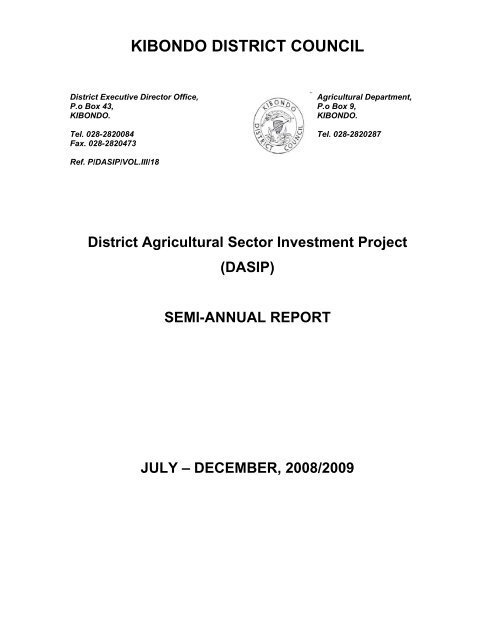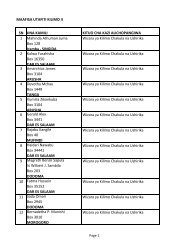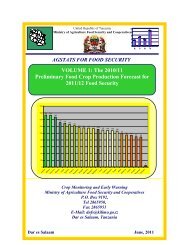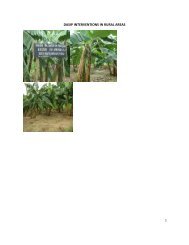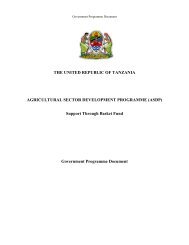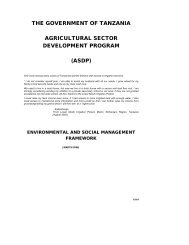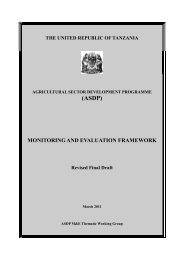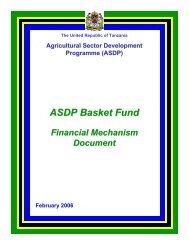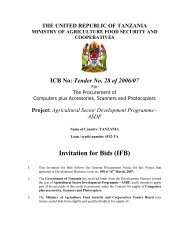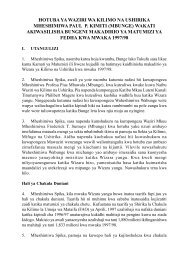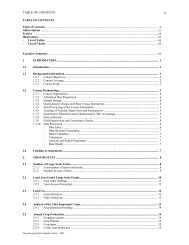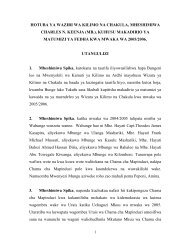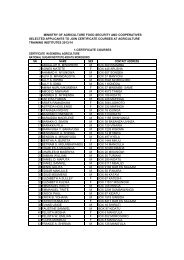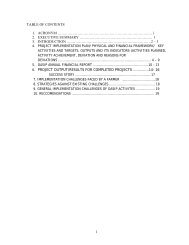Kibondo - Ministry Of Agriculture, Food and Cooperatives
Kibondo - Ministry Of Agriculture, Food and Cooperatives
Kibondo - Ministry Of Agriculture, Food and Cooperatives
Create successful ePaper yourself
Turn your PDF publications into a flip-book with our unique Google optimized e-Paper software.
KIBONDO DISTRICT COUNCILDistrict Executive Director <strong>Of</strong>fice,P.o Box 43,KIBONDO.Tel. 028-2820084Fax. 028-2820473Agricultural Department,P.o Box 9,KIBONDO.Tel. 028-2820287Ref. P/DASIP/VOL.III/18District Agricultural Sector Investment Project(DASIP)SEMI-ANNUAL REPORTJULY – DECEMBER, 2008/2009
List of abbreviationsDASIP District <strong>Agriculture</strong> Sector Investment ProjectFFS Farmer Field SchoolPFG Participatory Farmer GroupFP Farmer PracticeVADP Village agriculture development PlansPCU Project Coordinating UnityFCB Farmers Capacity BuildingCP Community PlanningFF’s Farmers FacilitatorsBOQ Bill of QuantitiesKIWOSA <strong>Kibondo</strong> Women SACCOSO & OD Opportunity <strong>and</strong> Obstacle for Development2
July – December DASIP progress report 2008/09KIBONDO DISTRICTIntroductionThis report gives the status of project implementation of the past six(6) monthsfrom July 2008 to December 2008. The report starts by listing the activitiescarried out in the period <strong>and</strong> goes on giving both physical <strong>and</strong> financial status oftheir respective implementation. It should be noted that activities done so farincludes implementation of the carried over activities from the fourth quarter offinancial year 2007/2008. The report also explains the performance of the FFS`sfor the past cropping season by comparing yields under FP <strong>and</strong> IPPM <strong>and</strong> all theimportant information from FFS`s. The component of monitoring <strong>and</strong>evaluation/verification of the planned activities were carried out in all DASIPtarget villages in the district. At the end, the report cites problems encounteredduring the period.These quarters verification of implementation of the past <strong>and</strong> activities plans for thefinancial year 2008/2009 was conducted under field appraisal, which was carried by PCUstaff in collaboration with district DASIP staff <strong>and</strong> the beneficiaries.- 3 -
2.0 Plan <strong>and</strong> implementation status2.1 Farmers capacity building• Senstization <strong>and</strong> formation of six more PFG’s for each village under DASIP.135 PFG’s out of 180 target in 2008/ 2009 have been formed.• Trainig of farmer facilitators.28 FF’s out of 30 targeted have received train on the major principles ofcrops <strong>and</strong> livestock production.• Distribution of agricultural inputs/training materials to villages under DASIP.135 PFG’s formed 2008/2009 have been supplied- 4 -
2.2 Community planning <strong>and</strong> investmentTable 1. Community investments 2006/2007/2008:FUNDS ISSUED2006/2007/2008Tsh. (000 )WARD VILLAGE PROJECT NAME BENEF. DASIP TOTALIMPLEMENTATION STATUSRehabilitation of rural<strong>Kibondo</strong> <strong>Kibondo</strong> feeder road. 2,400 9,600 12,000 Completed<strong>Kibondo</strong>Misezero<strong>Kibondo</strong>TwabagondoziCo-funded <strong>and</strong>Rice mill & Flourpackaging machine. 5,000 5,000 10,000procurementprocess beginConstruction of 4 boxculverts for rural feederroad 2,400 9,600 12,000 CompletedREMARKSCo-funded by KIWOSA <strong>and</strong>DASIP after the formerKabwigwa WomenAssociation failed to do so.MisezeroMisezeroTwabagondoziTwabagondoziConstruction of ruralfeeder road 1,600 6,400 8,000 BOQ preparedAt initial stageofConstruction of Cattleimplementationdip 3,000 12,000 15,000 (Construction)Due to delayed opening BankA/CDue to delayed opening BankA/CBusagaraMuhangeKasakaMuhangeRehabilitation of aCattle dip 1,340 5,360 6,700 CompletedCoffee pulpier machine-MUCUPA 5,000 5,000 10,000Co-funded <strong>and</strong>it is atprocurementstageDue to delayed opening BankA/C- 5 -
Kas<strong>and</strong>aKas<strong>and</strong>aRehabilitation of ruralfeeder road 1,200 4,800 6,000BOQ prepared<strong>and</strong> it is attender stageDue to delayed opening BankA/CKas<strong>and</strong>aKas<strong>and</strong>aConstruction of Cattledip 3,000 12,000 15,000Construction isat 80% ofimplementationDue to delayed opening BankA/CKasugaKinonkoRehabilitation of ruralfeeder road atKatengera Irrigationscheme 800 3,200 4,000TenderprocessingDue to delayed opening BankA/CRugongweKichanangaRehabilitation of ruralfeeder road 5,800 23,200 29,000TenderprocessingDue to delayed opening BankA/CNyabibuyeNyabibuyeConstruction of aSlaughter slab 800 3,200 4,000 CompletedGwanumpuBukiriloConstruction of aSlaughter slab 800 3,200 4,000TenderprocessingDue to delayed opening BankA/C33,140 102,560 135,700- 6 -
Table 2. Community investments 2008/2009:WARD VILLAGE NAME OFPROJECT1 <strong>Kibondo</strong> <strong>Kibondo</strong> Ruralfeederroad2 Gwanumpu Bukirilo Ruralfeederroad3 Itaba Kigogo Cropstoragefacility4 Kakonko Kanyonza Ruralfeederroad5 Kakonko Kabingo Ruralfeederroad6 Kakonko Itumbiko Ruralfeederroad7 Nyamtukuza Churazo CropstoragefacilityBEN.CONTR.TSHS.`000’DASIPFUNDSTSHS.`000’TOTALTSHS.`000”IMPLEMENTATIONSTATUS3,680 14,720 18,400 Transfer of moneyto respective projecta/c5,000 20,000 25,000 Transfer of moneyto respective projecta/c6,900 27,600 34,500 Transfer of moneyto respective projecta/c5,600 22,400 28,000 Transfer of moneyto respective projecta/cREMARKSCompliance delayof VADP actionplan to districthead quarterCompliance delayof VADP actionplan to districtCompliance delayof VADP actionplan to districtCompliance delayof VADP actionplan to district5,020 20,080 25,100 At BOQ stage Compliance delayof VADP actionplan to district3,000 12,000 15,000 At BOQ stage Compliance delayof VADP actionplan to district6,900 27,600 34,500 Transfer of moneyto respective projecta/cTOTAL 36,100 144,400 180,500Compliance delayof VADP actionplan to district- 7 -
3.0 Training of DASIP stakeholdersThere was no any training conducted to DASIP staff on first quarter.However, the Project <strong>Of</strong>ficers, the District <strong>Agriculture</strong> <strong>and</strong> livestockDevelopment <strong>Of</strong>ficers, The District Planning <strong>Of</strong>ficers <strong>and</strong> the DistrictExecutive Directors from all 28 districts implementing DASIP had a workshopin Mwanza. The objective of the workshop was to review the performance ofDASIP in the project area for the past two years. They reviewed theperformance <strong>and</strong> find solution to those problems which seemed to becommon in the project area in hindering effective implementation of theproject. At the end strategies to improve <strong>and</strong> fasten the speed ofimplementation were put.On the second quarter training of farmers facilitators were conducted, 28 FF’sfrom 28 villages under DASIP project were involved.4.0 SupervisionSupervision activities carried were to monitor <strong>and</strong> to verify the implementation ofthe above-mentioned projects. Project beneficiaries were advised open bankaccounts, forming six more PFG`s <strong>and</strong> their respective selected farmingenterprises for each village under the DASIP project, h<strong>and</strong>ing over of theirbusiness/project plans attached with the minutes to the DASIP district headquarter for further action before disbursement this project financial year. TheTraining Project Coordinator from PCU recommended on these during his visit inthe district at the end of this first quarter.5.0 Out put results so far achieved5.1 Farmers capacity building• Farmers have shown greater interest in farmers’ field school, extensionmethodology. They have recognized that, training through FFS havemore impact than the previous approach. Learning by doing sticksmore, <strong>and</strong> is easier to practice the skills to their field. The Umoja PFG- 8 -
of Kichananga village under FFS succeeded to produce <strong>and</strong> yield 336Kgs of groundnuts alongside the 180 Kgs under prior farmerspractices. Tumaini PFG of Kigogo village under FFS also succeeded toproduce <strong>and</strong> yield 15 bags of maize grains alongside the 3 bags underprior farmers practices. Maendeleo PFG of Mugunzu village under FFSalso succeeded to produce <strong>and</strong> yield 14 bags of maize grainsalongside the 3 bags under prior farmers practices.5.2 Community planning investment• Completion of Rehabilitation of rural feeder road at <strong>Kibondo</strong> village.There after, accessibility to <strong>and</strong> from Twabagondozi-Kilalangona havebeen made easier to be accessible throughout a year by projectbeneficiaries <strong>and</strong> other stakeholders in agricultural sector.• Construction of box culverts for rural feeder road also completed. Thishas made the feeder road free from been damaged by r<strong>and</strong>omlyrunning water across the feeder road.5.3 Lesson learned <strong>and</strong> experience gained• Village leaders show more commitment in project activities iffacilitated (trained in project management as well as monitoring<strong>and</strong> evaluation).• Farmers have appreciated FFS methodology as a means ofdisseminating knowledge to them. They said it is an enjoyable,funny methodology especially when referring to AESA6.0 Project to date6.1 Farmers capacity building• The total of 43 PFG’s formed last financial year (2007/2008) having atotal of 978 farmers of which 568 be males <strong>and</strong> 410 be females havebeen trained on the major principles of some different crops throughFFS’s accordingly.• PFG’s in each village under the DASIP project for 2008/2009 financialyear have been done, so far 135 out 180 FPG’s targeted have beenformed.• 28 FF’s out of 30 have been trained on the major principles of crop <strong>and</strong>livestock production.- 9 -
6.2 Community planning <strong>and</strong> investments• Among 13 micro projects for 2006/2007/2008, 4 have been completed<strong>and</strong> 9 at different levels of implementation not yet completed asdescribed on table 1 above.• In this 2008/2009 financial year, 7 village micro projects under DASIPhave been planed <strong>and</strong> financed as shown in table 2 above.Below is a success story from <strong>Kibondo</strong> village, regarding theRehabilitated Farm access road about 10 Km.<strong>Kibondo</strong> village is among the four villages of <strong>Kibondo</strong> ward. The village isimportant for various economic activities such as <strong>Food</strong> crops production.Most of these activities to the large extent are carried out farawaydistance (North-east) from the Village head quarter. According to MzeeHamisi Omari who is a resident of <strong>Kibondo</strong> village <strong>and</strong> is among farmersworking at Kilalangona area, said that “Before rehabilitation of the farmaccess road in the village, accessibility to <strong>and</strong> from the production areawas difficult due to water logging along the way especially during rainyseason which made transportation cost of the agricultural produce to berelatively high because initially it was not possible to hire a motor car tocarry the products <strong>and</strong> instead the product was been carried by using humanpower, which generally was expensive <strong>and</strong> also too laborious compared tonowadays where the products are easily carried by motor cars”. Hecontinued to explain that “Time spent to reach to the farm has been reducedsince the road has made a short cut resulting into increased working time<strong>and</strong> hence working area <strong>and</strong> production. After completion of feeder road,accessibility to <strong>and</strong> from the field has became easier <strong>and</strong> throughout theyear. We give much thanks to the project, donor <strong>and</strong> Tanzania government asa whole”. Mzee Hamisi Omari ended that.- 10 -
<strong>Kibondo</strong> – Kilalangona road aftercompletion of rehabilitation. .Farm products are nowadays easilycarried by motorcars7.0 Financial status of budget <strong>and</strong> disbursement2008/2009In these 1st two quarters the money transferred into <strong>Kibondo</strong> DASIP account wasmeant for, as described in the table below:-- 11 -
Table 3: Summary of disbursement <strong>and</strong> expenditure of fundsSNAmountdisbursedActivity Expenditure Balance Remarks1. 24,000,000.00 Mini -projects ofparticipatory farmergroups2. 90,000,000.00 Season longTraining of PFG’s11,200,000.00 12,800,000.00 Delay in openingbank a/c- Activityis going on5,602,400.00 84,397,600.00 Activity is goingon3. 2,300,000.00 PFG’s formation for 2,300,000.00 Nil2008/20094. 1,800,000.00 Motorcycle1,800,000.00 Nilallowances5. 1,350,000.00 <strong>Of</strong>fice operation &640,000.00 710,000.00 On going activitymaintenance costs-FCB&CP6. 5,025,000.00 District Staff field280,000.00 4,745,000.00 On going activityallowances7. 144,400,000.00 Village Micro Project 144,400,000.00 Nilimplementation8. 10,042,000.00 Training FarmerFacilitators(FF’s)5,102,000.00 4,940,000.00 Activity is goingonTotal 278,917,000.00 171,324,400.00 107,592,600.00Source: Disbursement record <strong>and</strong> expenditure report 2008/2009- 12 -
8.0 Problems <strong>and</strong> ChallengesThe following are the challenges/problems so far encountered.• Most farmers have low purchasing power the fact that makes them unableto budgets for their farms in the aspect of farm inputs. This made mostfarmers fail to apply what they learned from FFS in 2007/2008 croppingseason. However, they have taken this as a challenge <strong>and</strong> promised tobudget for the farm inputs ready to practice the skill they acquired in FFSin this 2008/2009 cropping season.• Transport for execution of project activities is still a problem despite thefact that project staffs have been provided with motorcycles. When thereis a need to travel as a team the vehicle is highly needed, since we sometime need to work as a team with other staffs like, engineers, communitydevelopment staffs, cooperative officers etc.• The procurement procedures take so long time, the fact thatleads/contributes to delayed implementation of planned activities.• Most farmers have low income in such that can not afford to organizethemselves <strong>and</strong> ask for 50% Co-funding Micro projects as a DASIPprecondition.• Inflation has interfered with DASIP budgets- rapid raise of farming inputse.g. Pesticides/ insecticides, fertilizers <strong>and</strong> building/ construction materialse.g. Cements.9.0 Way Forward• To emphasize training <strong>and</strong> community sensitization so that they cancontribute where required <strong>and</strong> implement their activity planned.• To facilitate capacity building training to all stakeholders for projectsustainability.
• To base on contract, efficiency <strong>and</strong> time specific to completeimplementation of planned activities for 2007/2008 <strong>and</strong> 2008/2009financial years.• To carry on monitoring <strong>and</strong> evaluation of project activities.10.0 Recommendation• We recommend the money provided as motorcycle maintenance <strong>and</strong>fuel allowance to be increased from the current seventy five thous<strong>and</strong>per month to one hundred fifty thous<strong>and</strong> due to the fact that, the costof maintenance as well as the price of fuel increases. The fundallocated as field allowance for staff doubled the current amount. Thisis because the execution of DASIP activities needs multi-disciplinarytechnocrats (i.e. engineers, technicians, cooperative officers, etc.) ofwhich the current budget cannot suffice.• Since that most of the farming enterprises especially crop productionsare seasonal, timely need <strong>and</strong> rain fed, if possible procurementprocedures for DASIP activities implementation to be revised byPCU.• The 50% Co-funding precondition to be revised at least to be 20%.11.0 ConclusionProvision of vehicles to the districts under DASIP, reviewing of somepreconditions <strong>and</strong> procurement procedures may increase the adoption<strong>and</strong>efficiency rates of Implementation of DASIP activities plans. The district hasplanned to do much better on implementation <strong>and</strong> supervision of the ongoingvillage micro projects for the past as well as this financial year. On top of that,monitoring <strong>and</strong> evaluation for the project activities need to be of paramountimportance to charter for efficiency, effective, economical <strong>and</strong> timelyimplementation of the planned activities.14


